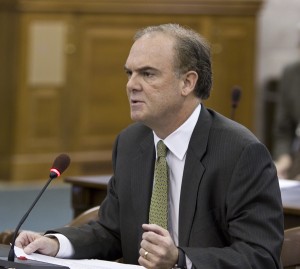The NJ Drinking Water Quality Institute met on Friday May 7. The meeting was held in the wake of recent controversies regarding DEP Commissioner Martin’s action to kill a proposed DEP standard for perchlorate (which led to this embarrassing cartoon and editorial: Cleaner Water) and the unusual resignation of long time Chair, Rutgers Dean Mark Robson.

On the Hot Seat. Further signs of disarray, Steve Jenniss of DHSS, served as Acting Chair. Jenniss was asked to serve as Acting Chair by DEP. The Chairman is appointed by the Governor, who has yet to act to fill this important post in the wake of Robson’s resignation.
Robson abruptly resigned in February, apparently in frustration over the DEP’s failure to adopt the perchlorate proposal and other important regulations to implement recommendations in the Institute’s major March 2009 Report: New Jersey Drinking Water Quality Institute Maximum Contaminant Level Recommendations for Hazardous Contaminants in Drinking Water)
In response to questions and criticism of his decision to kill the perchlorate proposal, in an unprecedented and false attack on DEP scientists, on April 27, Martin testified to the Senate about why he killed the DEP proposal (quotes from Martin testimony, per Bergen Record):
Under questioning from state Senate Majority Leader Barbara Buono during budget hearings on Tuesday, Martin said he originally intended to sign the proposed rule until he realized “our science was shoddy and I refuse to sign anything that doesn’t have adequate science to back it up.”
He said of the DEP researchers: “The data they provided was poor, not organized, anecdotal at best.” Martin also said nobody was able to document the public health risk of the chemical to his satisfaction.
As I wrote previously, Martin’s testimony is flat out false.
The DEP science and Institute recommendations that supported the DEP rule proposal were not shoddy or anecdotal, and they were not poorly organized. In fact, they were presented in detail to Martin. There was adequate science to support the proposed standard. There were current and rigorous risk assessment, toxicological data, and data on documented occurrences in NJ water supplies to demonstrate public health risks, click on links to see:
New Jersey Drinking Water Quality Institute Maximum Contaminant Level Recommendation for Perchlorate, October 7, 2005
Examine the scientific and public health justification for NJ standard
EPA Federal Register Notice – Regulatory Determinations for Priority Contaminants on the Second Drinking Water Contaminant Candidate List
And if Martin “originally planned to sign” the proposal, then why does the Red Tape Review Report state that the proposal was killed as follows:
“DEP will delay adoption pending the issuance of federal standards from EPA this summer and a more rigorous cost benefit analysis” (Source: Red Tape Report, Appendix G, @page 113 HERE.].
During the public comment period, I spoke at length to explain why the Drinking Water Quality Institute has a moral duty and professional obligation to set the factual and scientific record straight.
I strongly urged the DWQI members to defend the science, uphold the integrity of the Institute, and reaffirm the professional reputations of the scientists who conducted the analysis that formed the basis for the perchlorate rule Martin killed.
Martin’s false testimony has harmed these scientists both professionally and personally, and is therefore intolerable.
Tracy Carlucchio, with Delaware Riverkeeper and a member of the Highlands Council, raised similar concerns and supported my request that the Institute write a letter to Commissioner Martin that explains the science and advises him specifically why his statements are in error.
But instead of seeking a face saving way out of the mess Martin himself created by killing the perchlorate proposal, Martin is digging a deeper hole.
On Wednesday, Martin made another large mistake.
In a transparent attempt to shift the focus from the substance of his poor decision and false testimony, Martin tried to make the issues appear to be a petty partisan political battle.
In another unprecedented move for a DEP Commissioner (at least that I can recall, and I go back to 1985), the DEP Commissioner called out a legislative leader!
Martin issued a highly inappropriate and unseemly press release that explicitly challenged Senate Majority Leader Barbara Buono:
IMMEDIATE RELEASE: Contact: Lawrence Ragonese (609) 292-2994
May 5, 2010 Lawrence Hajna (609) 984-1795
COMMISSIONER MARTIN REFUTES STATEMENT BY SENATOR BUONO – WANTS GOOD SCIENCE TO BE BASIS OF PERCHOLRATE RULES
(10/P35) TRENTON – Department of Environmental Protection Commissioner Bob Martin today refuted a statement by Senator Barbara Buono, who contended he has done an “about face” on setting drinking water standards for the chemical perchlorate in New Jersey.
“I have not changed my position at all,” said Commissioner Martin. “From the start, I have insisted we need good, reliable data and scientific information before making such an important decision on water standards. We anticipate getting that information this summer, when we expect the federal EPA to share with us the results of research they have done and their direction on perchlorates.”
There are at least 5 discrete issues being conflated here, so let’s tease each one out:
1) The quality and status of the DEP science supporting the proposal
See above comments and links. Martin is just dead wrong – factually – in his statements.
Furthermore, the minutes from the DWQI’s last meeting on February 1 reveal that the Institute was fully aware of the quality and most recent science (which could only make the proposed 5 microgram/liter standard lower). The DWQI sought to reiterate their support for the perchlorate proposal in light of this new science, and advise Martin to proceed with adoption of the proposal:
The subcommittee expressed support for the DEP adoption of an MCL for perchlorate on 5 micrograms per liter MCL, as proposed prior to its expiration date. The subcommittee agreed revision of the perchlorate MCL would be considered only once it has been adopted, in light of this new information on infant exposure”
These same minutes also reveal that the Institute was carefully briefed in detail by DEP staffers about the impacts of Governor Christie’s Executive Order #2 and the possibility that it could force not only the perchlorate proposal, but other Safe Drinking Water Act rules to expire. Noting the exemption in Executive Order #2 for public health, Institute member J. Klotz (of UMDNJ) specifically suggested:
given their relevance to protection of public health, the drinking water rules caught in this “freeze” should be eligible for reconsideration (EO did allow for a 10 day window for each agency head [i.e. Martin] to review the list of rules, but that window expired on January 30)
The Feb. 1 minutes also show that then current members of the Institute attempted to brief newly appointed members on the perchlorate proposal, and seek their support.
DWQI decided that the DWQI perchlorate recommendation document would be circulated so that new DWQI can review it. Within three weeks, DWQI members would convey their opinions to Chairman Robson about whether the DWQI should recommend to the Acting DEP Commissioner that the perchlorate MCL be adopted. If DWQI members agree, Chairman Robson would send a letter conveying the DWQI recommendation to …the Acting Commissioner.
That effort failed. The new members did not sign off on the proposal, and the letter in support to Commissioner Martin was never sent. Perhaps this was the straw that broke the camel’s back and led to Robson’s resignation.
Regardless, the DWQI minutes show that everyone – including Commissioner Martin – was fully aware of the state of the science and the implications of Executive Order #2 on the proposal’s expiration date and need to act with urgency to avoid expiration.
That didn’t happen and it is the result of the polices set forth in Governor Christie’s Executive Order #2 , which seek consistency with federal standards and require cost benefit justification, and the mismanagement of Bob Martin.
But instead of accepting responsibility for that unpopular and reckless policy decision, Martin attacks DEP scientists and makes up lies about EPA allegedly pending rule this summer. Which leads us to our next point.
2) what EPA will allegedly decide “this summer”
One of the shifting pretexts Martin has offered to explain why he abandoned the proposal is “pending the issuance of federal standards from EPA this summer” (Source: Red Tape Report, Appendix G, @page 113 HERE.].
But as we revealed, an EPA March 12 email to Martin and a March 16 phone call specifically told Martin that EPA would NOT be issuing a drinking water standard this summer, but rather merely would make a preliminary decision about whether to regulate. In response to our disclosure, Martin has now revised his statements about exactly what EPA says it might decide “this summer”. Which takes us to our next point.
3) the timing of any EPA regulations that would be adopted;
EPA specifically advised Martin that no federal drinking water standard would be in effect in NJ for up to 6 and 1/2 years. Martin instead made misleading statements that implied EPA was about to impose a national standard and that was why abandoned NJ’s proposal – to wait for the federal standard. Marin continues to mislead on this, despite our disclosure, by suggesting that some new science with come forward from EPA. But, as EPA has advised Martin, EPA will be making a regulatory determination about whether to regulate. What EPA will do this summer is basically make a policy call on how to apply the science. On the status of the science, EPA also has specifically told Martin that EPA is no longer seeking National Academy of Science input, so the EPA so called new science Martin claims to be forthcoming is just not true.
4) The differences between the EPA 15 ppb guidance value and the proposed DEP 5 ppb MCL standard
The proposed DEP 5 ppb drinking water standard is based on the same toxicological science as the EPA 15 ppb guidance value. The toxicological basis is known as the “reference dose” (RfD). The DEP’s lower 5 ppb value is explained by the fact that EPA used different exposure assumptions and target population – EPA did not consider infants and DEP used a higher rate of water consumption by infants.
In fact, DEP submitted comments on EPA’s guidance value that were critical of EPA’s failure to consider risks to infants. We requested these comments ion a Open Public Records Request we filed to DEP, but DEP failed to provide these documents. We believe that Martin intentionally and illegally withheld these documents, because they not only show DEP science is strong, but that the EPA proposal he is waiting for is flawed.
The DEP comments pointing out the EPA flawed science was referenced by DEP in the rule proposal itself, where DEP wrote:
It should be noted that on October 10, 2008 USEPA issued a preliminary regulatory determination for perchlorate through its drinking water Contaminant Candidate List process (73 Fed.Reg., page 60262). USEPA preliminarily determined that a drinking water standard (MCL) for perchlorate is not needed. Instead USEPA will publish a final non-enforceable health based guidance level at the same time its final regulatory determination is issued. The USEPA regulatory determination established a drinking water Health Reference Level for perchlorate of 15 ug/l. The Department has submitted comments expressing concerns with the USEPA preliminary regulatory determination. The main points made in the comments are: 1) A health based level of 15 ug/l is not protective of infants, as they would be exposed to several times the RfD at this concentration. 2) USEPA should adopt a Federal drinking water standard, rather than drinking water guidance, since perchlorate occurs in public water supplies at levels of health concern at a frequency sufficient to warrant regulation. (proposal at page 6. emphasis supplied)
5) the technical basis for the federal EPA versus NJ DEP drinking water standards
We have been writing about cost benefit analysis (see this for great critique of CBA) and its role in undermining science and public health based standards.
A recent article in the Harvard Environmental Law Journal “Beyond Cost-Benefit Analysis: A Pragmatic Reorientation” it provides an outstanding analysis and includes very relevant case studies of mercury (clean air) and arsenic (drinking water) standards. The authors conclude:
This reorientation eschews the use of CBA, except where it is legally required, because it is unnecessary and irrelevant in other contexts, it lacks sufficient accuracy if relevant, and it pursues a normative vision of regulation that is inconsistent with the precautionary policies concerning protection of people and the environment that Congress has adopted.
This makes a CBA-centered RIA unnecessary and irrelevant to analyzing regulatory issues that arise under a statutory mandate. We make an exception for the rare circumstance where Congress has mandated the use of a cost-benefit test.
The second step is to determine the level of regulation by using the “statutory standard”. Statutory standards vary, but Congress has almost never chosen a cost-benefit test to establish the level of regulation. Only two of twenty-two major health, safety, and environmental statutes rely on a cost-benefit test as the statutory standard.
A comparison of federal and NJ Safe Drinking Water Act laws with respect to the role of CBA is an excellent illustration of these threats.
The federal Safe Drinking Water Act does authorize EPA to consider costs in setting minimum national drinking water standards (MCL’s). The article clearly explains how EPA develops federal MCL’s and exactly how CBA weakens them (source: about Harvard LR article):
The SDWA establishes a three-step process for regulation. First, EPA determines a “maximum contaminant level goal (“MCLG”), which the statute defines as “the level at which no known or anticipated adverse effects on the health of persons occur and which allows for an adequate margin of safety”343 EPA then specifies a maximum contaminant level (“MCL”) that comes as close as “feasible” to achieving the MCLG.344 Finally, if the benefits of the feasible MCL do not justify the costs, EPA may choose a MCL “that maximizes health risk reduction benefits at a cost that is justified by the benefits”345
But the NJ law is stricter and does not authorize CBA – which is a very good reason why the Christie Executive Order #2 cost benefit analysis justification and federal consistency policy are so flawed. Both CBA and federal consistency weaken NJ protections.
DEP very clearly distinguished the role of economic factors in EPA setting minimum national standards, from the stricter NJ SDWA, which does not allow costs to be considered as a factor in setting drinking water standards. Quoting DEP’s rule proposal, as we wrote on March 12:
The [NJ Drinking Water Quality] Institute considers three factors when recommending MCLs: health effects, technological ability to measure the contaminant level, and ability of existing treatment technologies to meet the MCL. For chemicals causing effects other than cancer (noncarcinogens), the goal is the elimination of all adverse health effects resulting from ingestion, within the limits of practicability and feasibility. The Federal standard-setting process considers these factors and an additional economic factor. (proposal at page 19-20)
So, not only is NJ DEP’s risk assessment and science stronger in considering risks to infants, but the NJ Safe Drinking Water law is stronger than federal law.
Which are solid reasons why – for 40 years – NJ has consistently had earlier, broader, and more stringent drinking water (and air, water, soil, pesticide, hazardous waste, chemical plant safety, right to know, pollution prevention, recycling, et al) standards that are far more stringent that federal EPA national minimum.
It is this tradition that Christie and Martin seek to destroy.
But, given the strong public support, they’re trying hard as hell to disguise that, and now even stooping to new lows in attacking DEP scientists.
Those efforts must cease.














